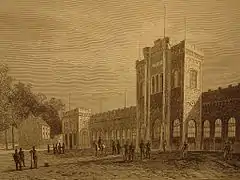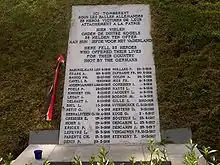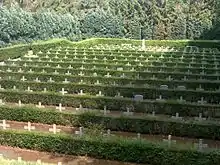Tir national
The National shooting range (French: Tir national, Dutch: Nationale Schietbaan) was a firing range and military training complex of 20 hectares (49 acres) situated in the municipality of Schaerbeek in Brussels. During World Wars I and II the site was used for the executions of civilians, prisoners and captured members of the resistance.
| Belgian National shooting range | |
|---|---|
Tir national Nationale Schietbaan | |
 Picture of the tir national by Ch. Trumper in 1872 | |

| |
| General information | |
| Town or city | Schaerbeek |
| Country | Belgium |
| Coordinates | 50.852778°N 4.403333°E |
| Construction started | 1886 |
| Opened | 1889 |
| Demolished | 1963 |
| Known for | Executions |
History
The first range was started in 1859 by Charles Rogier (Belgian minister of defence) and the mayor of Schaerbeek (Eugene Dailly) at the Prince Baudouin barracks in the Place Dailly.[1] This first range was abandoned in 1886 by the government due to obsolescence. Modernisation of weapons meant that longer ranges were required.
The shooting commission (Commission du Tir) decided to build a larger venue to permit members of the Garde Civique to practise over longer distances. In 1886 work was begun on a plateau at Linthout on the modern Reyerslaan. The centre opened in 1889. The building included a 600-metre (660 yd) indoor range which was used by the Garde Civique and army until 1945. In 1963 the centre was demolished. The site is now occupied by a media complex for the Belgian public service television RTBF and VRT.[1]
The centre had become a focus of Belgian patriotism. During both world wars it had been under the control of the occupying German forces and was used for executions. Amongst those executed at the site were the English nurse Edith Cavell (on 12 October 1915) and Gabrielle Petit (on 1 April 1916). In World War II, prisoners held at the Prison of Saint-Gilles were taken to the Tir national to be executed. The only remaining building is dedicated to Edith Cavell. There is a small cemetery, close to the present television centre, known as the enclos des fusillés. There are 365 tombs, and a pillar among the graves marks the location of the urn containing the remains of victims of the concentration camps in 1940–1945.
People executed at the Tir national


World War I
- Philippe Baucq, (Shot 12 October 1915)
- Edith Cavell, (Shot 12 October 1915)
- Gabrielle Petit, (Shot 1 April 1916)
World War II
- Abraham Fogelbaum, (Shot 21 January 1942)
- Adelin Hartveld, (Shot 21 January 1942)
- Victor Thonet, (Shot 20 April 1943)
- André Bertulot, (Shot 10 May 1943)
- Arnaud Fraiteur, (Shot 10 May 1943)
- Maurice Raskin, (Shot 10 May 1943)
- Gaston Bidoul, (Shot 20 October 1943 - member of Réseau Comète)
- Emile Delbruyère, (Shot 20 October 1943 - member of Réseau Comète)
- Jean Ingels, (Shot 20 October 1943 - member of Réseau Comète)
- Robert Roberts-Jones, (Shot 20 October 1943 - member of Réseau Comète)
- Georges Maréchal, (Shot 20 October 1943 - member of Réseau Comète)
- Albert Mélot, (Shot 20 October 1943 - member of Réseau Comète)
- Eric de Menten de Hornes, (Shot 20 October 1943 - member of Réseau Comète)
- Ghislain Neybergh, (Shot 20 October 1943 - member of Réseau Comète)
- Henri Rasquin, (Shot 20 October 1943 - member of Réseau Comète)
- Antoine Renaud, (Shot 20 October 1943 - member of Réseau Comète)
- Edouard Verpraet, (Shot 20 October 1943 - member of Réseau Comète)
- Alexandre Livchitz, (Shot 10 February 1944)
- Youra Livchitz, (Shot 17 February 1944)
- Lucien Orfinger, (Shot 26 February 1944)
References
Bibliography
- Tir National (in French), la commune de Schaerbeek, 17 December 2014, retrieved 21 January 2015
- History: "Ancienne caserne Prince Baudouin, dite également caserne Dailly" [Former Prince Baudouin barracks, also called Dailly barracks], Région de Bruxelles-Capitale - inventaire du patrimoine architectural (in French), Iris Monument, 2012, retrieved 21 January 2015
External links
![]() Media related to Tir national at Wikimedia Commons
Media related to Tir national at Wikimedia Commons